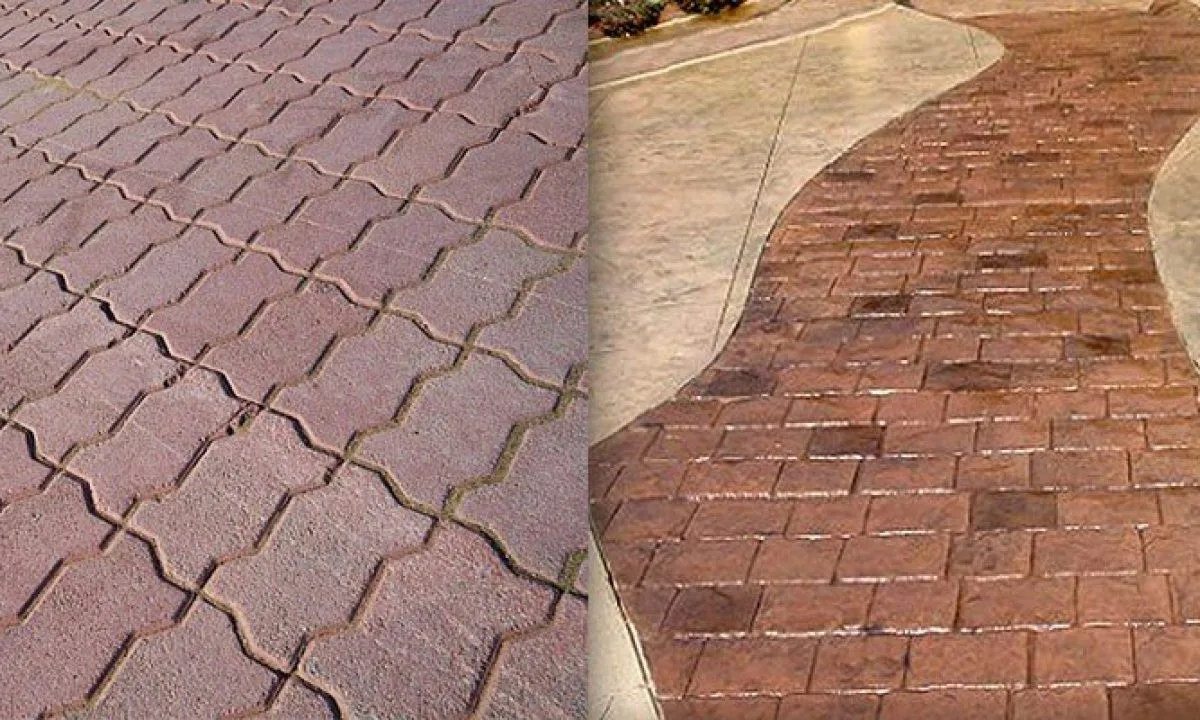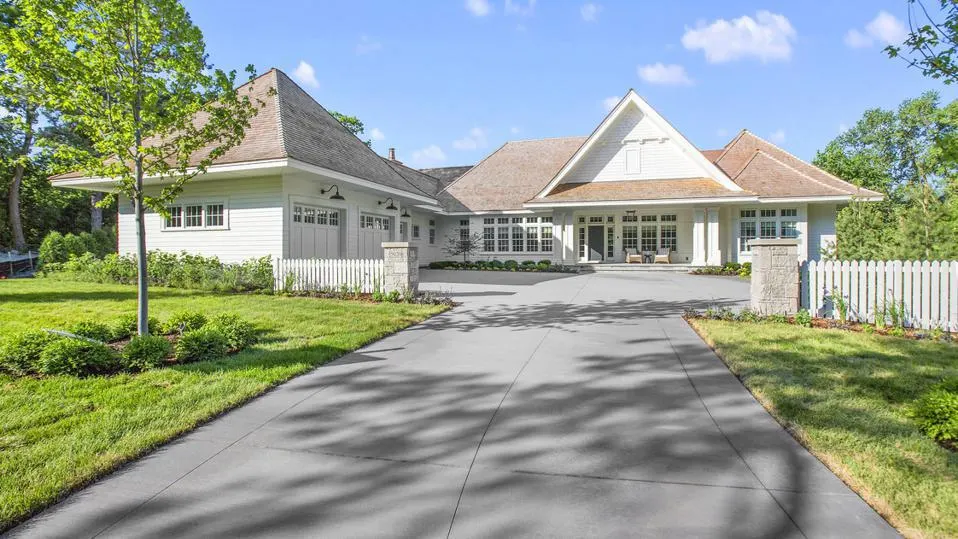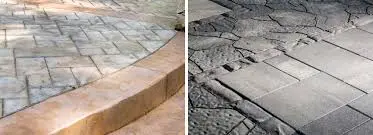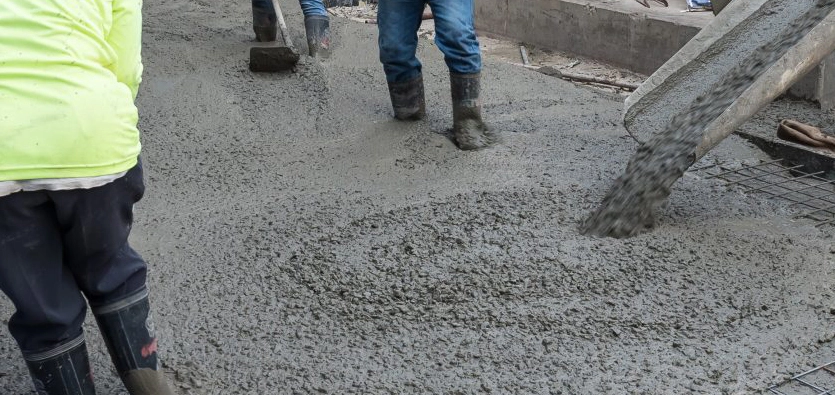Stamped Concrete vs . Pavers: What's Best for You?
Stamped concrete and pavers are popular for outdoor surfaces such as patios, driveways, and walkways. Stamped concrete involves pouring concrete and then imprinting it with patterns to resemble materials like brick, stone, or wood. On the other hand, pavers are individual units made of various materials like concrete, clay, or natural stone laid out on a base to create a surface.
When considering which material to use for your outdoor project, it's essential to understand the differences between stamped concrete and pavers and the factors that influence your decision.
Additionally, it provides a seamless surface, making it ideal for areas where you want a smooth, uniform look. However, stamped concrete may crack over time, especially in regions with freeze-thaw cycles or heavy foot traffic.
Conversely, pavers provide flexibility and longevity. Compared to stamped concrete, they are less likely to crack; if one does, replacing it without damaging the rest of the surface is simple.
Choosing the suitable material for your project is crucial to ensure longevity, functionality, and aesthetics. Factors to consider include:
Initial Installation Costs
Stamped concrete typically has lower initial installation costs compared to pavers. This is because stamped concrete involves pouring and stamping a single material, whereas pavers require individual units to be laid out and fitted together. However, the precise cost may differ depending on elements like the design's complexity, local labor costs, and the cost of materials.
Long-Term Maintenance Expenses
While stamped concrete may have lower upfront costs, it can incur higher long-term maintenance expenses. Periodically resealing stamped concrete surfaces is necessary to preserve their longevity and aesthetic appeal, particularly in high-traffic regions and harsh climates. Pavers, on the other hand, typically require less upkeep over time. The need for significant repairs can be minimized by replacing individual pavers that become damaged.
Factors Influencing Overall Cost
Several elements might affect the final cost, whether with pavers or stamped concrete for your outdoor project. Labor costs are significant, as intricate designs or large surface areas may require more installation time and expertise. Material costs also vary depending on the type and quality of concrete or pavers selected. Additionally, site preparation, such as excavation and grading, can impact the project's overall cost.
You may decide on a solution that fits your project's needs and budget by considering the upfront installation and ongoing maintenance costs and the variables affecting overall cost.
Design Options and Versatility of Stamped Concrete
The diversity and range of design options offered by stamped concrete are extensive. It can imitate the appearance of different materials, such as wood, stone, or brick, giving homeowners the desired look at a fraction of the price. Stamped concrete also allows for patterns, shapes, and size customization, making it suitable for traditional and contemporary designs.
There is a style to fit every taste and sensibility, whether you like the timeless appearance of brick pavers, the rustic beauty of natural stone, or the sleek elegance of concrete pavers. Additionally, pavers can be arranged in patterns such as herringbone, basket weave, or running bond, adding visual interest to your outdoor space.
Visual Impact and Curb Appeal of Both Materials
Stamped concrete and pavers can enhance your home's visual impact and curb appeal. Stamped concrete creates a seamless surface that exudes sophistication and charm, while pavers offer a timeless elegance that complements architectural style. All of these materials can assist you in making an aesthetically pleasing patio, gorgeous driveway, or inviting walkway that complements your style and raises the overall beauty of your home.

Strength and Resilience of Stamped Concrete
Stamped concrete is known for its strength and resilience. Stamped concrete surfaces are perfect for driveways, pathways, and patios because they can sustain large loads and foot traffic damage when placed and maintained correctly. Furthermore, stamped concrete offers long-term durability because it shifts and settles less quickly than other materials.
Interlocking Nature and Durability of Pavers:
Pavers are renowned for their interlocking nature, which enhances their durability and stability.
There is less chance of damage or cracks because of the interlocking design, which properly distributes weight over the surface. Pavers are excellent for various climates and environments because they can tolerate temperature variations, freeze-thaw cycles, and moisture exposure. Furthermore, pavers may be readily replaced if damaged without compromising the integrity of the entire surface.
Consideration of Climate and Environmental Factors on Material Lifespan:
The lifespan of pavers and stamped concrete is significantly influenced by climate and environmental conditions. Materials may deteriorate more quickly in areas with steep temperature swings or much precipitation. Stamped concrete can have its lifespan increased by proper sealing and upkeep, which shields it from moisture and ultraviolet light. Similarly, selecting high-quality pavers and ensuring adequate installation can enhance their resilience to environmental stressors.
By considering stamped concrete and pavers' strength, resilience, and environmental adaptability, you can choose the material that best suits your project needs and ensures longevity for years.
Understanding the maintenance requirements of stamped concrete and pavers is essential for preserving the beauty and functionality of your outdoor space. Let's explore the maintenance tasks associated with each material:
Cleaning and Upkeep of Stamped Concrete Surfaces:
Stamped concrete surfaces require regular cleaning and upkeep to maintain appearance and durability. Routine maintenance tasks include sweeping away debris, washing the surface with mild detergent and water, and promptly removing stains. Additionally, stamped concrete should be resealed every few years to protect against moisture penetration, UV damage, and wear. Proper maintenance helps extend the lifespan of stamped concrete and keeps it looking its best for years to come.
Maintenance Tasks for Pavers
Pavers also require regular maintenance to preserve their appearance and structural integrity. Sealing pavers with a quality sealant helps protect against stains, fading, and weed growth. Additionally, periodic inspections are necessary to identify damaged or loose pavers that must be repaired or replaced. Repairing pavers typically involves lifting and resetting the affected area, ensuring proper alignment and stability.
Time and Effort Required for Routine Care:
While stamped concrete may require less maintenance overall, it may need more intensive cleaning and resealing compared to pavers. Conversely, pavers may require frequent spot cleaning and occasional repairs but require less upkeep. Regardless of the material chosen, investing time and effort into routine maintenance is crucial for preserving your outdoor space's longevity and aesthetic appeal.
Understanding the installation process of stamped concrete and pavers is essential for planning your outdoor project. Let's explore the steps involved in each method:
Steps Involved in Pouring and Stamping Concrete:
The installation of stamped concrete begins with site preparation, which includes excavation, grading, and ensuring proper drainage. Once the site is prepared, a concrete mix is poured and leveled to the desired thickness. After the concrete is partially cured, a stamping tool creates the desired pattern and texture. Additional coloring or staining may be applied to enhance the surface's appearance. Finally, the concrete can be fully cured before sealing to protect against moisture and wear.
Preparation and Installation of Pavers:
Installing pavers involves several steps to ensure a durable and stable surface. First, the area is excavated and leveled to create a uniform base. The pavers are laid out according to the desired pattern, with spacing for jointing material. Once the pavers are in place, jointing sand is swept into the gaps to secure them and prevent shifting. Finally, the surface is compacted to ensure stability and durability.
Duration and Complexity of Each Installation Method
The duration and complexity of installing stamped concrete versus pavers can vary depending on factors such as the area's size, the design's intricacy, and the installers' skill level. Stamped concrete installation typically requires fewer steps and may be completed more quickly than paver installation. However, the complexity of stamping patterns and the need for precise finishing techniques can impact the overall duration and complexity of the process.
Considering climate factors is crucial when selecting stamped concrete and pavers for your outdoor project. Let's explore how each material performs in different weather conditions:
Performance of Stamped Concrete in Different Weather Conditions:
Stamped concrete can perform well in various weather conditions, but its performance may be affected by extreme temperatures and moisture levels. In hot climates, stamped concrete may be prone to surface cracking or fading due to prolonged exposure to sunlight.
Drainage Capabilities and Resistance to Freezing/Thawing Cycles for Pavers:
Pavers are known for their excellent drainage capabilities, making them well-suited for areas with heavy rainfall or snowmelt. Additionally, pavers are resistant to freezing and thawing cycles, as their interlocking design prevents shifting and cracking caused by fluctuating temperatures. This makes pavers a durable and reliable option for outdoor surfaces in regions with cold climates or frequent temperature variations.
Suitability of Each Material for Specific Climates or Regions:
Stamped concrete may be better suited for warmer climates with minimal temperature fluctuations, while pavers excel in areas with heavy precipitation or extreme temperature changes. Ultimately, the suitability of each material depends on factors such as local climate conditions, site characteristics, and maintenance practices. By considering these factors, you can choose the material that best meets the needs of your specific climate or region and ensures long-lasting durability for your outdoor project.
FAQs
Which is more affordable, stamped concrete or pavers?
Stamped concrete generally has lower initial installation costs than pavers. However, long-term maintenance expenses should also be considered when determining overall affordability.
How long do stamped concrete and pavers last?
Both stamped concrete and pavers can last many years with proper installation and maintenance. Stamped concrete may require periodic resealing, while pavers may need occasional repairs, but both materials offer long-lasting durability.
Can I install stamped concrete or pavers, or do Ineed a professional contractor?
While DIY installation is possible for stamped concrete and pavers, hiring a professional contractor is recommended to ensure proper installation and long-term durability. Professional installers have the expertise and equipment to achieve high-quality results and avoid common pitfalls.
Conclusion
Considering cost, durability, maintenance, climate compatibility, and aesthetic preferences is necessary when deciding between stamped concrete and pavers for any outdoor project. Stamped concrete offers versatility in design and affordability, while pavers provide durability, flexibility, and a wide range of design options.
If you're ready to transform your outdoor space with stamped concrete or pavers, contact a reputable contractor in your area. A professional installer can assess your project requirements, provide expert guidance, and ensure the highest-quality installation for lasting results.
Feel free to contact us for assistance or to schedule a consultation. Let's work together to bring your outdoor vision to life with the perfect stamped concrete or paver choice. Your dream outdoor oasis is just a step away!




